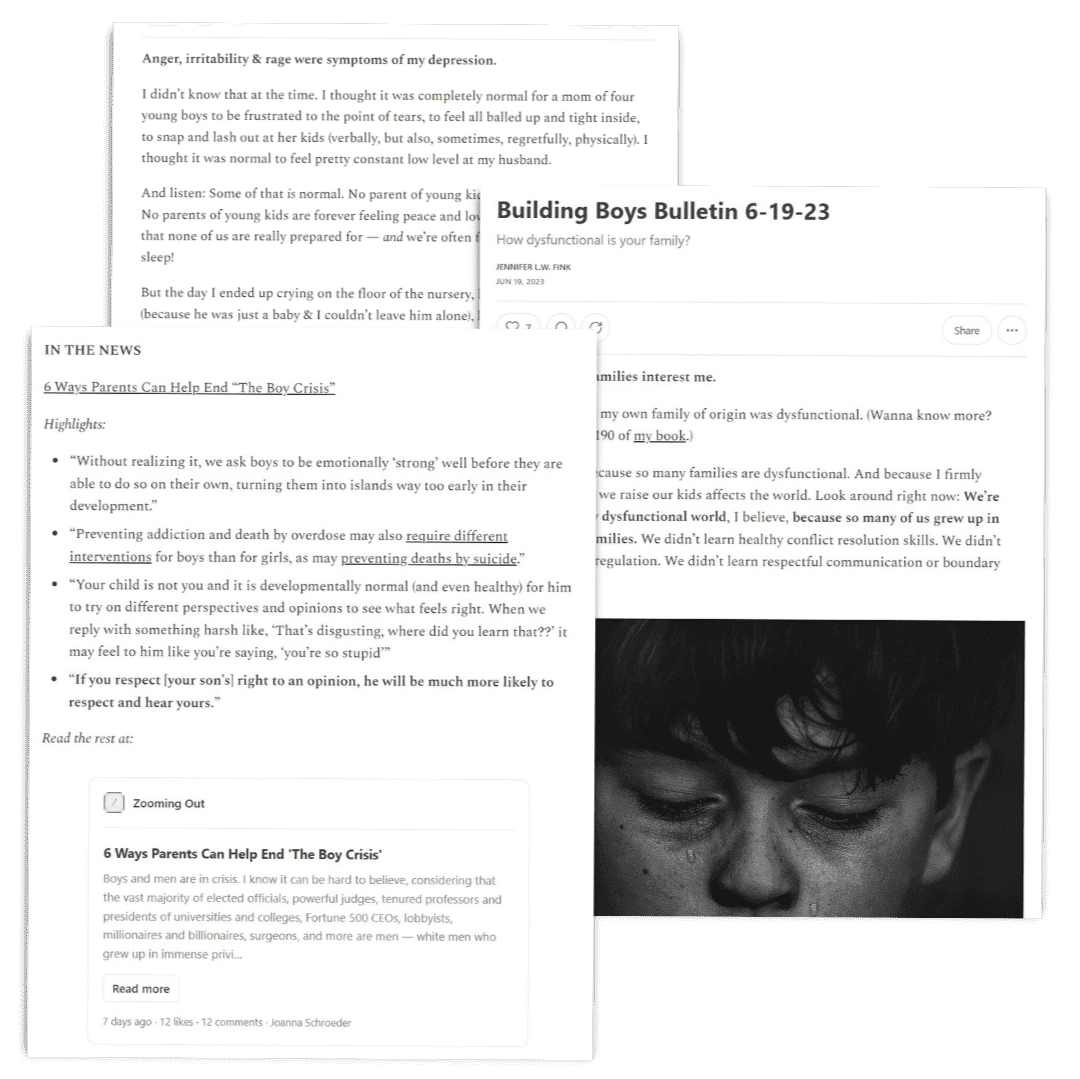
Perhaps the toughest thing for any mom of boys — and, I’d guess, female teacher of boys — is learning to understand boys.
I’ve never been a boy. I don’t know how they think, I don’t know why they do what they do and I don’t know how they feel. I don’t know what their day-to-day experiences are like or what it’s like to go through puberty as a boy. I don’t know, firsthand, how the world treats boys or how boys treat one another. I don’t know the challenges and strengths of boys simply because I’ve never lived or experienced any of it.
Yet if I’m to effectively parent these four children of mine (all boys), I need to understand them. I need to understand their world. I can’t effectively help my children navigate the world if I don’t know what they’re thinking and feeling and experiencing.
That much was made clear to me when my boys, then ages four and nearly two, spontaneously jumped to their feet from the floor — they’d been quietly watching TV — and began running and leaping from couch to couch in my living room. Their actions made no sense to me; nothing in my past or current experience could explain how or why someone could go from perfectly still and content to leaping off furniture, with no intervening event. Similarly, I couldn’t understand how or why they were constantly drawn to physical tussles, both with each other and with their father.
My boys’ actions were nonsensical to me, but their father — a former boy — reassured me that they were quite normal and that he too had done such things as a boy.
For the first time, I realized the gap between me and them. I realized that my boys’ experience and perception of the world was different than mine, and that I couldn’t simply parent them by applying the lessons and experiences of my own life. I’d always known my children were individuals, but until then, I’d never appreciated or pondered the ways in which sex and gender affect, well, everything. It truly hadn’t occurred to me that the experience of growing up “boy” could be radically different from the experience of growing up “girl.”
Yes, these things are basic. And yes, much of it is socially constructed. Also, yes, human beings should be treated as individuals instead of generic “males” or “females.”
But the world still treats and reacts differently to boys and girls. We can argue nature-vs-nurture all day long, but the bottom line is this: boys and girls are different, and whether that difference is largely due to biological factors or social factors, the difference is real. If we want to help boys (or girls), we first have to understand them and the challenges they face.
Want to more effectively parent (or teach) your boys? The 4 simple steps will help you understand, parent and teach boys:
Step #1: Observe
Watch your boys. Watch other boys too. Watch with an intention to understand and learn more about boys, their interests and their struggles. Try to watch without judgement; stop mentally categorizing things as “good” and “bad,” or even as “better” or “not as good.” Simply watch and learn what interests your boys, what intrigues them, what frustrates them and what makes them tick.
You’ll likely learn that other boys share your boys’ interests and struggles. You’ll learn that yours is not the only boy who thinks fart jokes are hilarious or has a hard time staying in his seat. You’ll learn a lot about how boys act and react, and a lot about the things they consider important.
Step #2: Read books about boys
The first book I read about boys was Michael Gurian’s The Minds of Boys: Saving Our Sons from Falling Behind in School and Life. The second was Why Gender Matters: What Parents and Teachers Need to Know About the Emerging Science of Sex Differences, by Leonard Sax. These books were eye-opening! For the first time, I understood that what I was seeing in my own home — my boys’ need for activity, their propensity for rough games – was not unique or unusual; rather, it was common to most boys throughout the world and throughout history. Even more importantly, I learned that my boys’ struggles with school and society were not unique. I learned, for the first time, about the cultural and societal factors stacked against boys.
These books gave me insight into the issues faced by boys, and those insights have helped me understand why my boys do what they do. They’ve also helped me anticipate challenges and respond effectively. Knowing that a fascination with weapons & battles is completely normal, for instance, keeps me from freaking out when my son chews a piece of toast into a gun or writes a violent story.
Step #3: Listen
I can learn a lot by carefully observing boys, and books help me understand the science behind why boys do what they do. But the only way for me to really understand boys’ experience is to listen to boys. Want to know why a boy hates school? Ask him — and let him know, through your words & deeds, that you really want to know the answer. That means putting aside your judgments. It means listening to what he says, instead of saying things like, “Oh, I’m sure it’s not that bad!” when he tries to tell you what school is like for him. It means being open to hearing things you’d rather not know. (It may also mean listening to story after story about his favorite NBA player or Pokemon character too.)
Listening also means listening to the other boys. That’s where books like Masterminds & Wingman come in. Why movies like The Mask We Live In are so valuable. They provide glimpses into the interior (and exterior) worlds of boys because they share boys’ experiences, in the boys’ own words.
Listen to men too. Yes, the world has changed since they were boys. But today’s men still understand the world of boys far better than most of us women do, simply because they’ve lived it. Chicago Tribune writer Paul Sassone recently caught me off guard with these words: “Boys — and those of us who once were boys — are used to being blamed for just about everything. Boys often spend hours sulking in their room sorrowfully pondering an unjust world that picks on them all the time.”
Huh. Until I read those words, I’d never thought about the amount of blame heaped on boys. I didn’t know that boys walk around with that weight on their souls. Yet now that I understand that fact, I can be much more sensitive to my boys. I can watch my language around them and make it point not to blame them for things that are beyond their control. I can solicit their comments about magazine articles and news stories that seems to place blame and responsibility on boys.
Step #4: Love
Yes, even if you’re a teacher. Loving our boys means showing an interest in them as human beings. It’s the putting-into-action of all the above steps. Boys have an uncanny knack for knowing who cares about them, and who doesn’t, and they will do nearly anything for someone they believe understands them and has their best interests at heart. (On the flip side, if a boy doubts your intentions or thinks you don’t care about him and his life, he’s likely to ignore or work against you.)
It takes time and effort to step out of our own experiences and into a boys’ life, but the effort is so worth it!







2 Responses
Another great post. Thank you Jennifer!
Try to see the continuum of behaviors created by differential treatment from lower to higher socioeconomics for boys. Try to see the allowed and even intentional more aggressive treatment given boys as early one year of age to make them tougher. Try to see how this differential treatment does create more impedance to thinking, learning, motivation to learn (mental reward received for mental work expended). To see how this differential treatment hurts boys more so as they are given more aggressive treatment – we need to redefine average stress more correctly as many layers of mental work from our past, present, future – experiences, fears, preparations for defense, agitation from unresolved mental conflicts, aggressions given them; etc. It is these layers of mental frictions from that more aggressive treatment to make them tough that fills their minds more with “maintained higher layers of average stress that take away real mental energy” leaving less mental energy for learning. The lower the socioeconomic bracket and less stable the more amplified that more aggressive treatment. Try to see how this creates more activity for stress relief (socially created); higher muscle tension that hurts handwriting/motivation; and more social/emotional distance/wariness of parents/teachers/adults. Try to see how the much less mental, emotional, social, verbal interaction, and less support for fear of coddling creates more lags in social, verbal, academic skills. The combination of this and higher average stress hurts reading, sentence structure, communication, and other social/emotional needs. Try to see how boys are given love and honor only on condition of some achievement. When not achieving they are given more discipline and ridicule to make them try harder, although they are being poorly trained for the information age. Try to see how girls are given more kind, stable, verbal interaction and support simply for being girls. Try to see how differential treatment is creating more high achieving minority girls and many more failing minority boys. Even in middle to upper class areas girls are doing better collectively due to more aggressive, less supportive treatment for boys. We need to look at this very large elephant in the room.